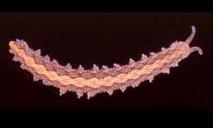
(onychopheran) |
The PANARTHROPODA
|
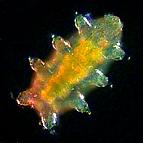
(tardigrade) |

(onychopheran) |
The PANARTHROPODA
|

(tardigrade) |
===========O=== Onychophora (velvet worms; fossil Hallucigenia)
|
<<=======P==========| ====T=== Tardigrada (water bears)
===1===|
====A=== Arthropoda
|
b) ventro-lateral legs (lobopods) with hooked tips c) must molt to grow d) chemical makeup of cuticle e) ectodermal cilia lost f) extensive hemocoel ('open' circulatory system), coeloms reduced g) heart with openings to hemocoel (ostia) h) panarthropodan sensilla b) unique oral papillae b) tri-partite cerebral ganglia (proto-, deuto-, & tritocerebrum) c) loss of circular muscle layer | b) loss of nephridia c) claws of anterior legs modified into stylets & stylet supports d) tri-radiate, myo-epithelial sucking pharynx b) two tagmata (head, trunk) c) calcification of cuticle d) fully segmental sclerites (body-wall cuticular plates) e) each body segment has 2 sclerites (dorsal tergum, ventral sternum) f) two-part appendages: basal protopod + distal, multi-segmented part (telopod) g) complete loss of motile somatic cilia/flagella (some sperm retain flagella) h) unique hemocyanin respiratory pigment |
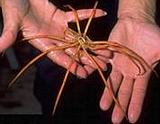
(pycnogonid sea spider)
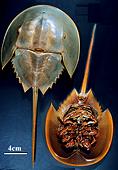
(horseshoe crab)
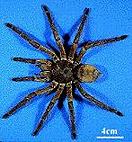
(true spider)
Phylum ARTHROPODA
(tree/traits: Brusca & Brusca 1990 p. 485, 538, 589, 598, 659, 683, 691;
taxa in FULL UPPER CASE indicate the four arthropod subphyla)
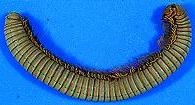
(diplopod myriapod)

(chilopod myriapod)
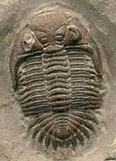
(extinct trilobite)
==A========= Arachnida (spiders, mites, scorpions, etc.)
==C==|
========= CHELICERATA ===========| ==X========= Merostomata (horseshoe crabs)
| |
| ===P============= Pycnogonida (sea spiders)
|
<<=| ===== TRILOBITOMORPHA ======================== (extinct trilobites)
| |
| | ====== Symphyla (symphylans)
| | ==S==|
| | | ====== Chilopoda (centipedes)
| | ===Myriapoda======|
=T==| | =========== Diplopoda (millipedes)
| |
| == UNIRAMIA ==| ==Entognatha=== Collembola (springtails)
| | | |
| | ==Hexapoda====| == Thysanura (silverfish and firebrats)
| | (Insecta) ==Ectognatha=|
=M=| == Pterygota (winged insects)
|
== to CRUSTACEA ===========================================================>
TRAITS SUPPORTING EACH CLADE (** plesiomorphic- a primitive state, not unique to clade):
|
b) mouth lies before segment 1 embryologically c) segment #1 limbs= chelicerae (no antennae; may be pincer-like or fangs) d) segment #2 limbs= palps or pedipalps b) 1st or 2nd abdominal segment modified as genital somite b) ovigers (unusual 3rd pair limbs) c) abdomen (=opisthosoma) reduced or absent d) long, 9-segmented walking legs e) multiple pairs of gonopores on some/all legs f) loss of compound eyes b) loss of compound eyes b) abdominal limbs modified as book gills c) long, spiked telson b) segment #1 limbs= antennae c) 4 pair post-oral head segments with biramous limbs similar to thoracic limbs b) body dorso-ventrally flattened c) limbs of post-oral head segments similar to limbs of thorax (all with two branches, biramous?)** | b) 5 pair head appendages (2 pair antennae, 1 pair mandibles, 2 pair maxillae) c) body segment cuticle of 4 sclerites (tergum, 2 lateral pleura, sternum) d) mouth anterior to segment 3 in adult b) mandible is 'whole-limb' c) unique tracheal system d) uniramous limbs (exopodite lost) b) loss of compound eyes c) loss of palps on first & second maxillae d) repugnatorial glands b) maxillipeds modified as raptorial poison fangs b) 3-segment thorax with limbs c) 11-segment abdomen, no limbs
|